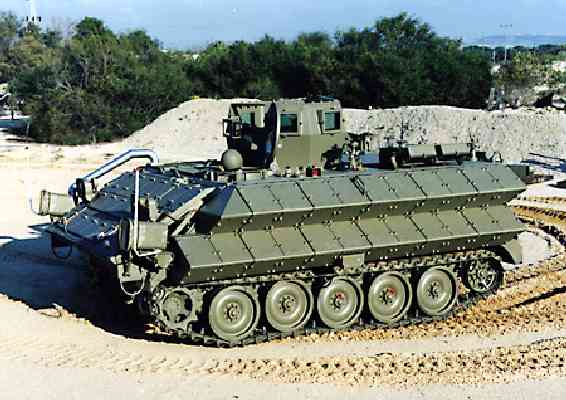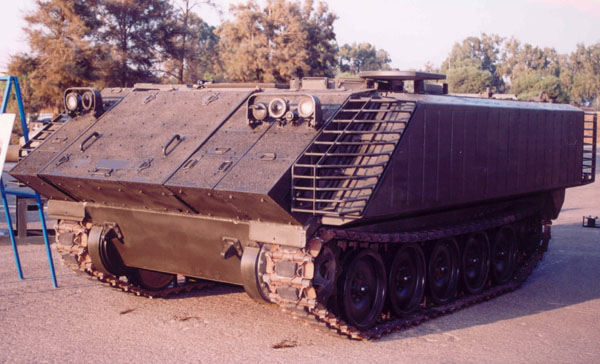Aussie M113 upgrade hits a brake
-
1.Why so diffcult to upgrade M113?
M133 upgrade hits a brake,Daniel Cotterill,November 25, 2006
http://www.theaustralian.news.com.au/story/0,20867,20776975-5002142,00.htmlDEFENCE'S troubled project to upgrade 350 armoured personnel carriers has encountered further difficulties. A fault in a new braking system that can see discs and callipers grind has further delayed their introduction into service -- now November next year at the earliest.
2.spore upgraded long time ago
The $500 million project has for the past 10 years been variously dogged by mismanagement, political and bureaucratic vacillation, and technical complications - all on what started out to be a simple upgrade to extend the life of the Vietnam-era fleet by several years.
The Defence Materiel Organisation is supervising the upgrade's prime contractor Tenix Defence and brake supplier FFG to ensure the brake problems are fixed, and that rectification does not create a maintenance burden for the M113 fleet.
There have been calls for the project to be cancelled.
While advocating the upgrade go on if difficulties can be resolved, Neil James, executive director of the Australia Defence Association, says "the upgrade stemmed from flawed strategic thinking and we should have procured a real infantry fighting vehicle instead."
Defence is adamant that the mix of mobility, firepower and protection offered by the upgraded M113s will see the fleet offer a useful capability until their planned withdrawal in 2020, but not everyone agrees. According to James, "it is ludicrous that the ADF will be one of the few Western military forces that cannot field a single infantry fighting vehicle, especially to integrate with our new tanks and armed helicopters".
An infantry fighting vehicle (IFV) is a more lethal, better-protected class of vehicle than an armoured personnel carrier such as the M113. Infantry can also fight with and from an IFV and, given the close-quarter battles our soldiers are increasingly being called upon to face, a move to a more capable and heavily armed vehicle is ultimately inevitable.
Better capability and protection come at a cost, however, and a typical IFV weighs in around 25-30 tonnes compared to the 18 tonnes of an upgraded M113.
By 2012 two of the expanded army's eight infantry battalions will be mechanised. Unless the M113 upgrade is sorted out quickly they may feature IFVs sooner rather than later -- a number were on prominent display at the land warfare conference last month.
Know ur Singapore M113 taxi2. The company won the contract, believed to be worth over S$300 million, in 1993 and began delivering upgraded M113s to the Singapore Armed Forces in 1994 for trials. The upgrade programme is now complete. Singapore Technologies Kinetics is now marketing this M113 upgrade programme to other countries.

Specifications
M113
Max speed forward on level hard ground: 74 km/h
Max forward speed on soft ground and 50% gradient: 8-10 km/h
Max speed in low range: 22 km/h
Acceleration from 0 to 32 km/h: 9 s
Creep speed range (continuous): 200 to 5,000 m/h
Drift on hard paved ground: 0.5 m in 100 m
Braking (32 to 0 km/h): 10 m
Average cross-country speed: 42 km/h
Turning radius (pivot to infinite): 7.5 m at 7 s/360º
Pivot steer radius/time: 4.5 m at 8s/360º ----i like this feature.
3.Ask Aussie pass the biz to ST lah
M113 Upgrade
The M113 has been completely transformed from a conventional troop carrier into a superior fighting vehicle, with outstanding mobility and performance to match
4.Reasons for delay
1.Corruptions is the only answer!
2.pl give me your guess. -
Maybe ST should take over their upgrade, i am sure with our efficiency such problems can be solved.

-
How do we know that our M113 upgrades had no major issues compared to the Aussies ? In Australia, the issues were made public ; in Singapore, such
issues ( if any ) will never be aired in public. -
quite true hereOriginally posted by glock:How do we know that our M113 upgrades had no major issues compared to the Aussies ? In Australia, the issues were made public ; in Singapore, such
issues ( if any ) will never be aired in public. -
The IDF had very bad experiences with the original M113.
This quote from
http://www.israeli-weapons.com/weapons/vehicles/armored_personnel_carriers/m-113/M-113_.html
"Because the hull was made from aluminium, once hit by an RPG (rocket propelled grenade) fires raged furiously and there was almost no escaping the vehicle. The M113 earned its unofficial name Zippo and crew preferred to ride on the vehicleÂ’s roof, taking the risk of exposing themselves to enemy fire rather than staying put in the flammable confines of the Bardehlas. "
So the IDF set about upgrading the armour protection of its fleet of M113 based on its very up -to-date battle experience.
And here are some examples.


Our upgraded M113 Ultras are also supposed to have more armour protection.
But compare our upgraded M113 to the Israeli ones. Somehow, our Ultra doesn't look anywhere nearly as serious in improving armour protection compared to the Israeli ones.
-
3rd pic of the M113. See before liao. We do have similar add on like this back in the late 80s/early 90s.
-
I won't be surprised that our M113 Ultras have add on armour. This is because, even the old SM1 have add on armour, its just that not many knew about this.Originally posted by Manager433:3rd pic of the M113. See before liao. We do have similar add on like this back in the late 80s/early 90s.
-
2.At least MINDEF dared to declare the upgraded M113 is full operationalOriginally posted by glock:How do we know that our M113 upgrades had no major issues compared to the Aussies ? In Australia, the issues were made public ; in Singapore, such
issues ( if any ) will never be aired in public.
capacity and marketing overseas.Sg is less corruption so issues can be ironed out faster.
3.pl note the brochures is prepared by ST Kinetic co in Canada.
Will you dare to sell defective products to international clients?
4.6. The upgraded M113 is the first Singapore Armed Forces armoured vehicle to receive passive armour protection. These Singapore-developed appliqué armour slabs, understood to be ceramic, are also designed to negate the penetrating effects of shaped charges from HEAT and HESH rounds.
----
An enlarged trim vane has been added for improved stability during amphibious operations due to the increase in combat weight of the up-armoured M113A2.
see part 2 posted on the same day.
ARMOURED PERSONNEL CARRIERS (TRACKED), Singapore
Date Posted: 21-Sep-2004
Jane's Armour and Artillery
http://www.sgforums.com/?action=thread_display&thread_id=149071
5.You will be a fool if tell the details of armours. -
Yes, the brochure said that our M113 Ultra have added on armour.Originally posted by tankee1981:I won't be surprised that our M113 Ultras have add on armour. This is because, even the old SM1 have add on armour, its just that not many knew about this.
What I meant was that the armour add ons don't look like much compared to the IDF ones. And we all know the IDF knows the score well when it comes to armour protection. -
do other ACP has this feature as our upgraded M113?
Turning radius (pivot to infinite): 7.5 m at 7 s/360º
Pivot steer radius/time: 4.5 m at 8s/360º -
Our M113 armor addon upgrade and removal of fuel tanks to external are a good improvement to original M113. However, the upgrades are still very far from what Israelis have done to their M113s
Our upgraded M113s can probably take hits up to 14.5 mm AP and 155 mm fragments. It will certainly be badly damaged by a RPG although probably not as badly as the original M113 with Al armor. -
I heard that they have to consider the amphibious capability of our Ultra unlike IDF.Originally posted by moca:Yes, the brochure said that our M113 Ultra have added on armour.
What I meant was that the armour add ons don't look like much compared to the IDF ones. And we all know the IDF knows the score well when it comes to armour protection.
Therefore there is limit on how much uparmouring for our Ultra w/o losing that capability, that is why Ultra have an enlarged trim vane installed. -
That is very true...Originally posted by glock:How do we know that our M113 upgrades had no major issues compared to the Aussies ? In Australia, the issues were made public ; in Singapore, such
issues ( if any ) will never be aired in public.
Also we do not know the nature of the Aussie M113 upgrade. Maybe their upgrade is much more complex then Singapore's....
On a seperate note, remember when we re-engine the A4 with F404 engine some 15 years back. There was an improvement in performance but concurrently a increase in strain in the airframe! -
-
30 Jul 2005 ,
Catch the newest war machines at NDP
The Mechanised Igla will participate in the NDP Mobile Column display. DSTA pdf. file
was responsible for integrating the IGLA weapon system onto the M113 Armoured Personnel Carrier. DSTA also developed the command and control of the various sub-systems, including the radar and navigation system to offer the system better mobility, speed and accuracy.
from 20 july 2005,/www.dsta.gov.sg
2.while Aussie is sill studying how to upgrade,we hace fixed IGLA in M113. -
Good point.Originally posted by gary1910:I heard that they have to consider the amphibious capability of our Ultra unlike IDF.
Therefore there is limit on how much uparmouring for our Ultra w/o losing that capability, that is why Ultra have an enlarged trim vane installed.